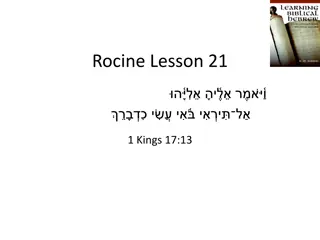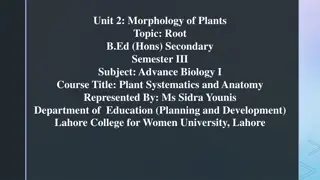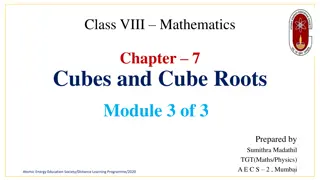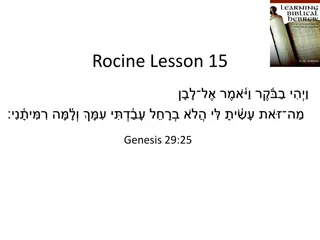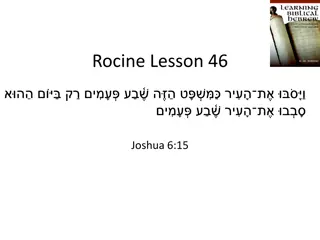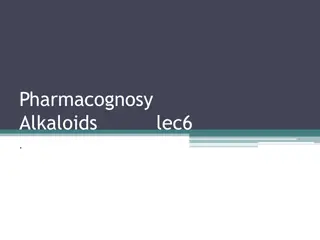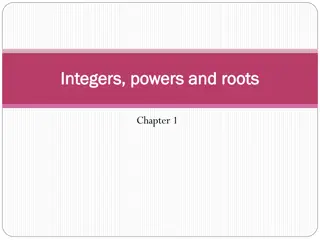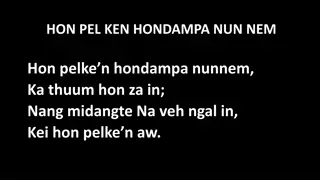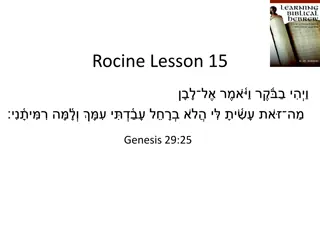Understanding Qal Wayyiqtol Forms Derived from First Nun Roots
Explore the identification and reading of Qal wayyiqtol forms derived from first nun roots in Leviticus 8:23. Learn about the prefixes, dagesh patterns, and characteristics unique to these forms, including the distinction between Qal and Piel verbs. Dive deep into recognizing wayyiqtols and understanding their significance in Hebrew grammar.
Download Presentation

Please find below an Image/Link to download the presentation.
The content on the website is provided AS IS for your information and personal use only. It may not be sold, licensed, or shared on other websites without obtaining consent from the author. Download presentation by click this link. If you encounter any issues during the download, it is possible that the publisher has removed the file from their server.
E N D
Presentation Transcript
Rocine Lesson 9 Leviticus 8:23
Goals Identify and read Qal wayyiqtol forms derived from first nun [ ] roots and .
Goals Identify and read Qal wayyiqtol forms derived from first nun [ ] roots and .
Goals Identify and read Qal wayyiqtol forms derived from first nun [ ] roots and .
Goals Identify and read Qal wayyiqtol forms derived from first nun [ ] roots and . III- I-
Goals Identify and read Qal wayyiqtol forms derived from first nun [ ] roots and . III- I- also
Goals Identify and read Qal wayyiqtol forms derived from first nun [ ] roots and . also III- I- also
Goals Identify and read Qal wayyiqtol forms derived from first nun [ ] roots and . also III- I- Just to be clear There is no such thing as I- or I- verbs. These are not classes of verbs. and are just two individual verbs, albeit very common verbs, that happen to follow the I- and I- patterns respectively. also
What we already know How many wayyiqtols can you spot? What does a string of wayyiqtols indicate?
First nun roots Examining our two wayyiqtols you should notice some similarities. What is the prefix vowel? What kind of dagesh is in the consonant following the prefix?
First nun roots dagesh forte hireq dagesh forte hireq
First nun roots dagesh forte hireq dagesh forte hireq
First nun roots dagesh forte hireq dagesh forte hireq Looks a bit like a Piel but it s not. It s just a plain Jane Qal. Piels have a shewa under the prefix no dagesh forte in the next letter. E.g. (Rocine Lesson 2)
First nun roots dagesh forte hireq dagesh forte hireq Looks a bit like a Piel but it s not. It s just a plain Jane Qal. Piels have a shewa under the prefix no dagesh forte in the next letter. E.g. (Rocine Lesson 2) So what is it?
First nun roots dagesh forte hireq dagesh forte hireq It s a first Nun verb where the first Nun has assimilated to the next consonant so you get two of them and it is written as a dagesh forte.
What is Assimilation? In English, in is a prefix negator for many words. ability -> inability active -> inactive
What is Assimilation? In English, in is a prefix negator for many words. ability -> inability active -> inactive mobile ->
What is Assimilation? In English, in is a prefix negator for many words. ability -> inability active -> inactive mobile -> inmobile ??
What is Assimilation? In English, in is a prefix negator for many words. ability -> inability active -> inactive mobile mobile -> -> inmobile ?? immobile The n has assimilated to the next consonant and become an m .
What is Assimilation? In English, in is a prefix negator for many words. ability -> inability active -> inactive mobile mobile -> -> inmobile ?? immobile modest -> immodest moral -> immoral mature -> immature In Hebrew, the resulting double letter is written with a dagesh forte.
First nun roots dagesh forte hireq dagesh forte hireq So, what we see here is the result of assimilation.
First nun roots dagesh forte hireq dagesh forte hireq So, what we see here is the result of assimilation. And happens to follow the I-Nun pattern.
Missing Letter Rule #3 RULE: When the first root letter which appears in the wayyiqtol (or yiqtol) verb form is doubled by a dagesh forte, the first root letter is a missing first nun or the special case of the first lamed meaning take .
Piel or I-Nun Rocine calls the dagesh resulting from an assimilated nun a dagesh footprint .
Piel or I-Nun RULE: A dagesh cannot be both the sign of the Piel stem and a footprint dagesh at the same time. I.e., if we have a footprint dagesh, we have the Qal stem. In the Piel stem, a first nun does not assimilate.
Piel or I-Nun RULE: A dagesh cannot be both the sign of the Piel stem and a footprint dagesh at the same time. I.e., if we have a footprint dagesh, we have the Qal stem. In the Piel stem, a first nun does not assimilate. Genesis 45:15 And he kissed [Piel]... Nun does NOT assimilate because it is in an open syllable. No intervening vowel between it and the next consonant. It is at the end of a closed syllable that Nun will tend to assimilate.
4 types of missing letter verbs Rocine 10 Missing Letter Rules
4 types of missing letter verbs Compare Rocine 10 Missing Letter Rules
Verb Analysis Person, Gender, Number Root meaning Root Stem Form Function
Verb Analysis Person, Gender, Number Root meaning Root Stem Form Function Historical Narrative Mainline Qal Wayyiqtol 3ms To give
Verb Analysis Person, Gender, Number Root meaning Root Stem Form Function
Verb Analysis Person, Gender, Number Root meaning Root Stem Form Function Historical Narrative Mainline Qal Wayyiqtol 3ms To take
Verb Analysis Person, Gender, Number Root meaning Root Stem Form Function Historical Narrative Mainline Qal Wayyiqtol 3ms To give Historical Narrative Mainline Qal Wayyiqtol 3ms To take
Prepositions This mem is part of the preposition . Note the dagesh in the following dalet. This is an assimilated nun, a footprint dagesh , as we have seen with I-Nun verbs. See Animatedhebrew Lecture 8 - Preposition Min (11:25) for details.
4 types of missing letter verbs Compare Rocine 10 Missing Letter Rules





